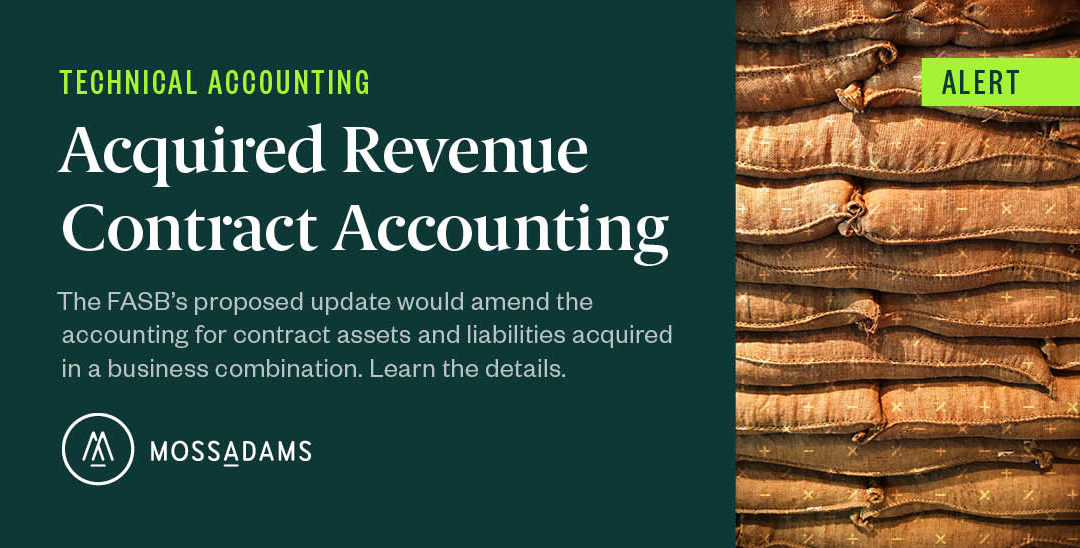This article, "Proposed Improvements for Acquired Revenue Contracts with Customers," originally appeared on MossAdams.com.
In effort to address the inconsistency and diversity in practice for the accounting of acquired revenue contracts with customers, the Financial Accounting Standards Board (FASB) is proposing to require contract assets and contract liabilities acquired in a business combination to be recognized and measured in accordance with Topic 606, Revenue from Contracts with Customers. The proposed amendments would improve comparability for both the recognition and measurement of acquired revenue contracts with customers at the date of and after a business combination.
Proposed Accounting Standards Update (ASU), Business Combinations (Topic 805)—Accounting for Contract Assets and Contract Liabilities from Contracts with Customer, was issued on December 15, 2020. Comments on the proposed ASU are due March 15, 2021.
Background
When applying the acquisition method in Topic 805, an acquirer generally recognizes and measures identifiable assets acquired and liabilities assumed in a business combination at fair value. While current Generally Accepted Accounting Principles (GAAP) provides guidance on how to measure assets and liabilities in a business combination, it doesn’t provide guidance specific to contract assets and contract liabilities arising from revenue contracts with customers and other similar contracts that are accounted for in accordance with Topic 606.
Under current guidance in Topic 805, an acquirer recognizes an assumed contract liability at fair value when the acquiree has received consideration up-front from the customer and there’s a remaining unsatisfied obligation as of the acquisition date.
Alternatively, when a contract is paid overtime as performance occurs, an acquirer wouldn’t generally recognize a contract liability as there wouldn’t be an identifiable asset or liability assumed as of the acquisition date.
While the timing of payment shouldn’t affect the amount of revenue recognized by an acquirer, in current practice, post-acquisition revenue will generally differ for a revenue contact that is paid up-front prior to the acquisition when compared to a revenue contract that is paid overtime after the acquisition.
Key Provisions
To improve comparability and eliminate diversity in the accounting for acquired revenue contracts with customers in a business combination, the proposed amendments would provide guidance on how to recognize and measure those contract assets and contract liabilities in a business combination.
By adding an exception to the measurement principle under Topic 805 for contract assets and contract liabilities, an entity—or acquirer—would be required to recognize and measure contract assets and contract liabilities acquired in a business combination in accordance with Topic 606.
Recognition of an Acquired Contract Liability
At the acquisition date, the acquirer would use the definition of a performance obligation—as defined in Topic 606—to determine whether a contract liability from an acquired revenue contract should be recognized. In accordance with Topic 606, a contract liability should generally be recognized if the acquiree has been paid for goods or services promised in the contract for which control hasn’t been transferred to the customer.
Applying Topic 606 to acquired contract liabilities will generally result in the acquirer recognizing the contract liabilities consistent with how they were recognized and measured in the acquiree’s financial statements—if the acquiree prepared financial statements in accordance with GAAP.
Subsequent Revenue Recognized by Acquirer
To address the issue that the timing of payment for an acquired revenue contract affects the subsequent amount of revenue recognized by the acquirer, the proposed amendments would require acquired contract assets and contract liabilities to be measured in accordance with Topic 606 at the acquisition date. This means that an acquirer would no longer measure the remaining obligations of the acquired revenue contract at fair value but, instead, utilize the contract transaction price for the remaining performance obligations in accordance with Topic 606.
Aligning the post-acquisition revenue recognized with the satisfaction of the performance obligations will result in a consistent approach to recognizing revenue that isn’t generally affected by the timing of payment.
Scope
The proposed amendments would apply to all entities that enter into a business combination within the scope of Subtopic 805-10 after the adoption of Topic 606.
The amendments in the proposed ASU wouldn’t affect the accounting for other assets or liabilities that may arise from revenue contracts from customers in a business combination, such as customer-related intangible assets and contract based intangible assets.
Effective Dates
The proposed amendments would be applied prospectively to business combinations occurring on or after the effective date of the issuance of a final ASU. Early adoption would be permitted, including adoption in an interim period.
We’re Here to Help
For more information on how the proposed amendments could affect your business, contact your Moss Adams professional.


